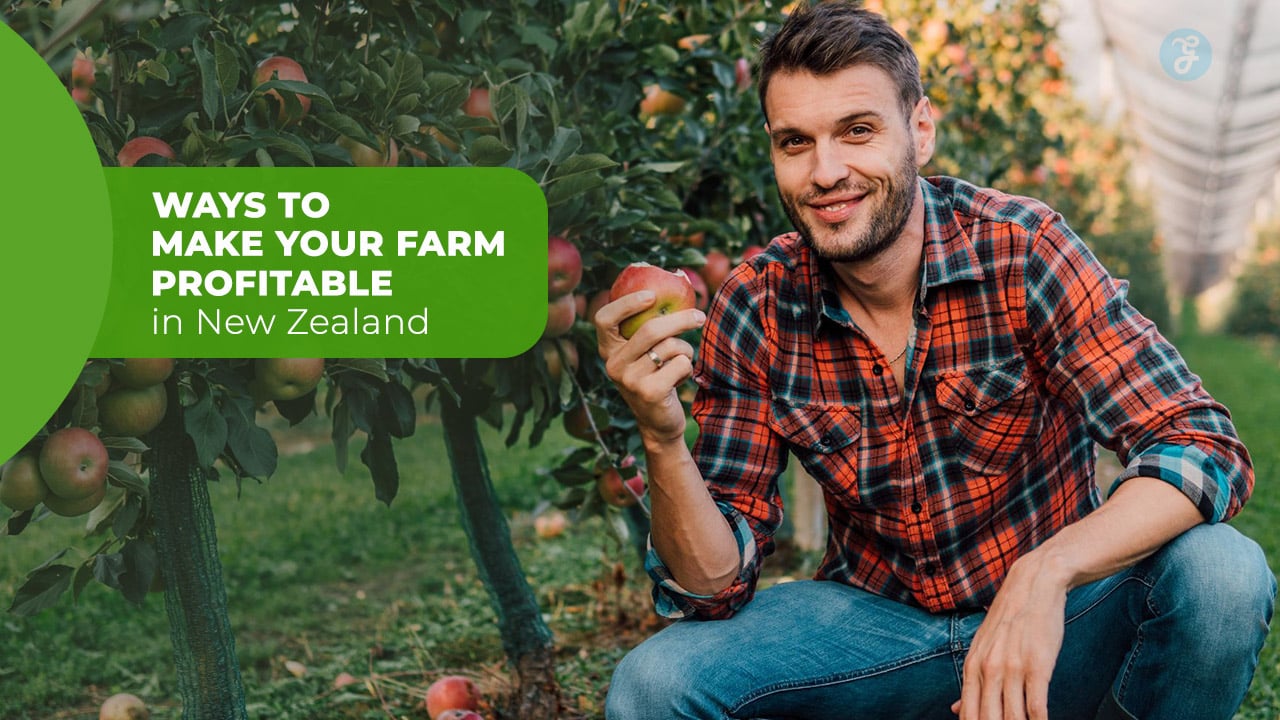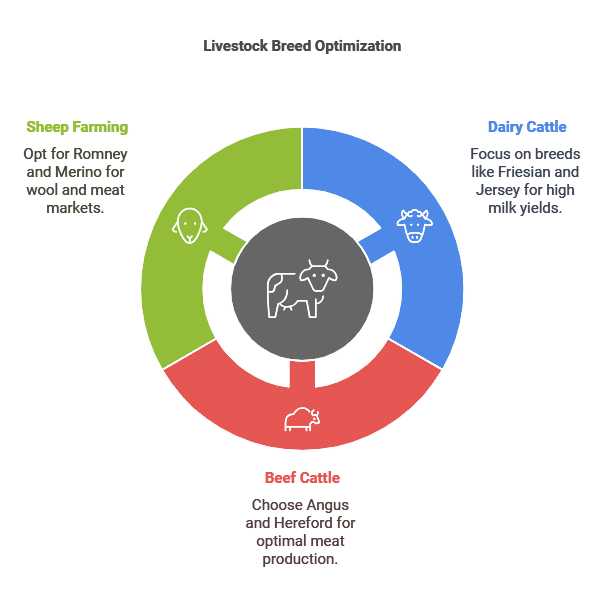Farming is a cornerstone of New Zealand’s economy, deeply embedded in its culture and identity. However, the increasing costs of production, fluctuating market prices, and environmental challenges make profitability a pressing concern for farmers.
Turning your farm into a sustainable and profitable enterprise requires strategic planning, diversification, and adopting modern technologies.
This comprehensive guide outlines five proven ways to make your farm profitable in New Zealand. From optimizing livestock management to adopting sustainable practices, each strategy is designed to help farmers thrive in the competitive agricultural landscape.
Whether you’re a seasoned farmer or new to the industry, these insights will provide actionable steps to maximize profitability while ensuring sustainability.
1. Optimize Livestock Management
Efficient livestock management is the backbone of profitability for many New Zealand farms. By focusing on the right breeds, grazing techniques, and technological advancements, you can boost productivity and reduce costs. With the right strategies, farmers can significantly improve yields, reduce losses, and maintain healthier herds.
Choose the Right Breeds for Your Goals
- Dairy Cattle: Breeds like Friesian and Jersey are renowned for high milk yields and adaptability to New Zealand’s climate.
- Beef Cattle: Angus and Hereford are popular choices for meat production, offering excellent growth rates and market demand.
- Sheep Farming: Romney and Merino breeds are ideal for wool and meat, catering to both domestic and international markets.
| Breed | Purpose | Key Benefits |
| Friesian | Dairy Production | High milk yield, resilient in NZ climate |
| Angus | Meat Production | Rapid growth, high-quality beef |
| Merino | Wool and Meat | Premium wool, dual-purpose utility |
Improve Grazing Practices
- Rotational Grazing: Dividing pastures into paddocks and rotating livestock improves grass regrowth and soil health.
- Grazing Benefits: Rotational grazing can increase forage yield by up to 20% and improve livestock health.
| Grazing Method | Benefits | Challenges |
| Continuous Grazing | Simpler management | Overgrazing risks |
| Rotational Grazing | Boosts pasture regrowth and productivity | Requires careful planning |
| Strip Grazing | Maximizes feed utilization | Labor-intensive setup |
Embrace Precision Livestock Farming (PLF)
- What is PLF? Technologies like GPS trackers and automated feeding systems monitor livestock health and productivity in real time.
- Benefits: Reduce labor costs, prevent diseases, and optimize feed usage.
- Example: A Waikato dairy farm reduced feed wastage by 25% by adopting automated feeding systems, increasing annual profit margins.
2. Diversify Your Income Streams
Relying on a single source of income can be risky in agriculture. Diversification provides financial stability and opens new revenue streams. Farmers in New Zealand are increasingly exploring innovative ways to supplement their traditional farming income, ensuring resilience against market fluctuations.
Add Agri-Tourism Activities
- Farm Stays: Transform your property into a rural retreat, attracting tourists seeking authentic farm experiences.
- Interactive Tours: Offer hands-on activities like milking cows or picking produce.
- Case Study: A Waikato dairy farm increased annual revenue by 15% after introducing farm tours.
| Activity | Description | Income Potential |
| Farm Stays | Accommodation in farm settings | High, depending on location |
| Interactive Tours | Guided activities for tourists | Moderate to high |
| Seasonal Events | Harvest festivals, workshops | Seasonal but profitable |
Grow High-Value Crops Alongside Livestock
- Popular Crops: Avocado, kiwifruit, and manuka honey are lucrative options.
- Integration Tips: Plant crops in unused land or as hedgerows to maximize space.
- Example: A Northland farm incorporated kiwifruit alongside sheep farming, generating an additional $50,000 annually.
Explore Value-Added Products
- Ideas: Produce artisanal cheese, organic wool products, or gourmet honey.
- Example: A Canterbury farm’s handmade cheese brand doubled their profits within three years.
| Product Type | Key Benefits | Market Considerations |
| Artisanal Cheese | High-value niche market | Requires branding efforts |
| Manuka Honey | Global demand | Certification needed |
| Organic Fertilizers | Sustainable farming trend | Requires initial setup |
3. Invest in Sustainable Farming Practices
Sustainability is not just an environmental responsibility but also a pathway to long-term profitability. Consumers increasingly prefer eco-friendly products, creating new market opportunities. Implementing these practices ensures lower costs and better resource management.
Leverage Renewable Energy Sources
- Solar Panels: Harness solar power to reduce electricity costs.
- Wind Turbines: Generate renewable energy on windy properties.
- Subsidies: New Zealand’s government offers grants for renewable energy projects.
| Renewable Source | Benefits | ROI Timeline |
| Solar Panels | Reduces electricity bills | 5-7 years |
| Wind Turbines | Sustainable energy generation | 8-10 years |
| Biomass Energy | Utilizes organic waste | 3-5 years |
Reduce Input Costs Through Composting and Recycling
- Composting: Turn organic waste into nutrient-rich compost.
- Benefits: Save on fertilizers while improving soil health.
- Example: A Hawke’s Bay vineyard reduced chemical fertilizer use by 40% by implementing composting practices.
Adopt Water-Saving Irrigation Techniques
- Drip Irrigation: Delivers water directly to plant roots, minimizing waste.
- Rainwater Harvesting: Store rainwater for dry periods.
- Environmental Impact: Reduce water usage by up to 50%.
| Technique | Benefits | Challenges |
| Drip Irrigation | Precise water delivery, less evaporation | High setup cost |
| Rainwater Harvesting | Cost-effective and sustainable | Storage requirements |
| Mulching | Retains soil moisture and prevents erosion | Labor-intensive setup |
4. Improve Market Access and Branding
Connecting with consumers and building a strong brand identity are crucial for increasing farm profitability in New Zealand. Farmers who successfully market their products can achieve premium pricing and greater consumer loyalty.
Build a Strong Online Presence
- Website: Create a farm website showcasing your products and services.
- Social Media: Use platforms like Instagram and Facebook to engage with customers.
- E-Commerce: Offer online sales for local and international customers.
| Online Tool | Purpose | Cost |
| Farm Website | Showcase products, accept orders | Moderate |
| Social Media Ads | Targeted promotions | Affordable |
| E-Commerce Platforms | Enable direct sales | Moderate to high |
Join Co-Operatives and Farmer Networks
- Benefits: Gain access to shared resources, bulk purchasing, and collective marketing.
- Examples: Fonterra, New Zealand’s largest dairy co-op, supports small farmers.
| Co-Op Name | Key Benefits | Membership Requirements |
| Fonterra | Shared resources, global market | Dairy farmers only |
| Beef + Lamb NZ | Marketing support, research access | Livestock farmers |
Focus on Organic and Specialty Markets
- Growing Demand: Organic produce and niche products fetch higher prices.
- Certification Process: Meet New Zealand’s organic standards to attract premium buyers.
5. Utilize Data-Driven Decision Making
Data-driven farming allows you to make informed decisions, optimize operations, and maximize profits. Harnessing technology for insights helps farmers allocate resources efficiently.
Implement Farm Management Software
- Features: Real-time tracking of crop yields, livestock health, and expenses.
- Examples: Tools like FarmIQ and AgriWebb are popular in New Zealand.
- Benefits: Improve efficiency and reduce waste.
| Software | Features | Cost |
| FarmIQ | Comprehensive farm management | Subscription-based |
| AgriWebb | Livestock-focused management | Affordable plans |
| Trev | Data sharing and benchmarking | Moderate pricing |
Analyze Market Trends and Consumer Preferences
- Market Insights: Use data to predict demand and plan production accordingly.
- Pricing Strategies: Adjust prices based on market conditions and competition.
Conduct Regular Financial Reviews
- Budget Planning: Track expenses, revenues, and return on investment (ROI).
- Actionable Tips: Review financial data quarterly to identify areas for improvement.
| Financial Metric | Importance | Tracking Frequency |
| ROI | Measures profitability | Quarterly |
| Expense Ratio | Tracks cost efficiency | Monthly |
| Revenue Growth | Evaluates sales trends | Biannually |
Takeaways
Making your farm profitable in New Zealand requires a combination of traditional practices and modern innovations. By optimizing livestock management, diversifying income, embracing sustainability, improving market access, and using data-driven approaches, you can transform your farm into a thriving enterprise.
Stay ahead of industry trends, leverage available resources, and continuously adapt to market demands. With the right strategies, you can ensure long-term profitability and contribute to New Zealand’s vibrant agricultural sector.










































